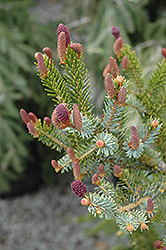It's all about ...
plants

Height: 50 feet
Spread: 40 feet
Sunlight:
![]()
Hardiness Zone: 4a
Other Names: syn. Picea bicolor
Description:
This Japanese species of Spruce is conical with graceful horizontal branches; if central leader is pruned out it will become more shrubby; unique green foliage with silver blue undersides, violet purple cones are breathtaking; an outstanding focal point
Ornamental Features
Alcock's Spruce is primarily grown for its highly ornamental fruit. The purple fruits are held in abundance in spectacular cones in mid spring. It has attractive green foliage with silvery blue undersides. The needles are highly ornamental and remain green throughout the winter.
Landscape Attributes
Alcock's Spruce is a dense multi-stemmed evergreen tree with a distinctive and refined pyramidal form. Its relatively fine texture sets it apart from other landscape plants with less refined foliage.
This is a relatively low maintenance tree. When pruning is necessary, it is recommended to only trim back the new growth of the current season, other than to remove any dieback. It has no significant negative characteristics.
Alcock's Spruce is recommended for the following landscape applications;
- Accent
- Mass Planting
Planting & Growing
Alcock's Spruce will grow to be about 50 feet tall at maturity, with a spread of 40 feet. It has a low canopy with a typical clearance of 1 foot from the ground, and should not be planted underneath power lines. It grows at a medium rate, and under ideal conditions can be expected to live for 50 years or more.
This tree should only be grown in full sunlight. It does best in average to evenly moist conditions, but will not tolerate standing water. It is not particular as to soil type or pH. It is somewhat tolerant of urban pollution, and will benefit from being planted in a relatively sheltered location. This species is not originally from North America.
This plant is not reliably hardy in our region, and certain restrictions may apply; contact the store for more information.
